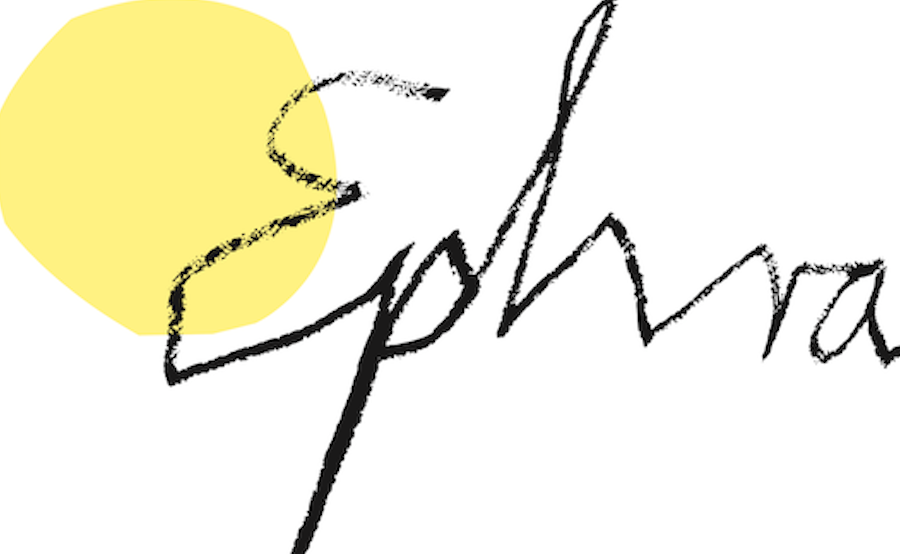How Karin Kerkmann paints with water
"Where we are standing right now, camels often used to stand." That's what artist Karin Kerkmann says when she warmly welcomes us to the courtyard of the Atelierhaus in Alt-Treptow, which includes her studio. When a circus was in town, it was allowed to camp here (where once there was a meadow) and let the camels graze. But those days are gone, because new apartment buildings have been built around the courtyard and the circus has had to find a new place to pitch its tents. Karin has been part of the studio house for a long time - more than 16 years it would have to be.
Her studio consists of a bright, rather small room with a view of the courtyard. Looking out the window, instead of animals we now see some planters and beds that Karin has planted. And there are lots of creatures hanging on the walls. It looks as if they are flowing out of the wall, because the bright paper barely stands out against the white wall. Before we take a closer look at the delicate creatures, we want to get to know Karin better, so we ask her a few questions. How did she get the idea to become an artist?
Even as a child, Karin loved being creative and making things come to life out of her imagination. That's a great power, she thinks. For example, she built cities out of moss and sticks and played with them. Over time, she has noticed that she has her own view of the world and the things around her that she wants to express. She does this mainly with watercolors, brushes and lots and lots of water. But she also takes photographs and develops spatial installations. For this, she looks around at the exhibition venues and sees what particularly interests or fascinates her. In a church, that was the entrances and exits, the windows and how the light falls in. She photographed all that and projected the photos onto the walls with a slide projector, a kind of beamer. In a way, she rebuilt the space, because all of a sudden it looked like you could walk through closed walls or climb down another wall (while it was just the projection of the steeple steps).
Karin erzählt uns, dass Malen sie besonders glücklich macht und zur Ruhe kommen lässt – es ist fast wie Meditieren. Sie zeichnet nie vor, was entstehen soll. Der Zufall ist ganz wichtig und sie malt aus dem Bauch heraus. Es muss nichts Konkretes werden; es geht eher um die Form und die Überraschung darüber, was gerade entsteht. Dabei ist sie ganz konzentriert und guckt genau, wie sich die Farbe bewegt. Mit Aquarell kann man nämlich sehr gut mit der Bewegung arbeiten und darauf reagieren, wie das Wasser fließt. Ein bisschen haben die Wesen also einen eigenen Willen.
Wir nehmen uns ein paar Minuten und sammeln, was wir in Karins Wasserwesen alles entdecken. Irgendwie wirken sie lebendig und gleichzeitig so, als könnte man durch sie durch- oder in sie hineingucken. Wir sehen ein Gehirn, eine sprießende Kartoffel, einen Schmetterling, Blumen, eine Lunge, ein Monster, einen Arm. Und eine Mischung aus Tier und Herz, ein Alien, einen Unterkörper, eine Schnecke, einen Pilz, ein Baby im Bauch, zwei Fußsohlen… Je länger wir hinschauen, umso mehr entdecken wir.
Karin says that in the process there are always pictures that are fun to paint but that she is still not convinced of. But that's not a problem, because then she simply takes a new piece of paper and starts again. (There is a whole pile of such works under the table.) Out of ten pictures, there is perhaps one that feels right straight away.
How long does she need for a painting? It's hard to say, Karin admits. She often paints ten pictures in a row, for example. And because she is so in the flow, she only needs half an hour for the eleventh that feels right. But if there hadn't been the ten attempts before, she wouldn't have got to the eleventh either. I wonder if it will be the same for us.
Karin has prepared painting boards for us on which the paper is fixed with adhesive tape. Because you paint mainly with water, the paper can wavy quite a bit. Most of us have never used watercolour before and it is totally unfamiliar to take up little colour but all the more water. There are so many pigments in the paint that a quick tap is usually enough.
We swing the soft brushes (which should never be left on the tip in the glass) and let ourselves drift. While we do this, we listen to a CD with nature sounds, as Karin usually does. The time is over far too quickly and perhaps not all the pictures created feel right yet. But we know what to do then - just keep on painting!







